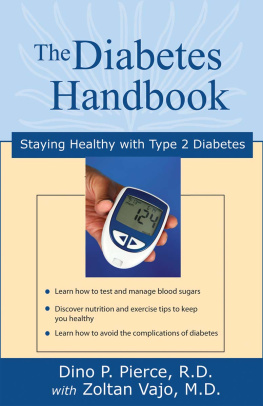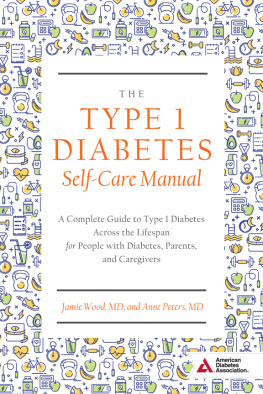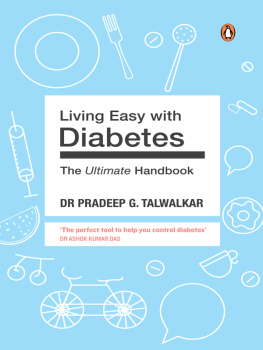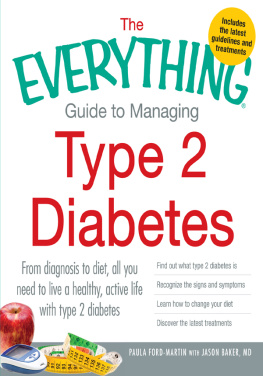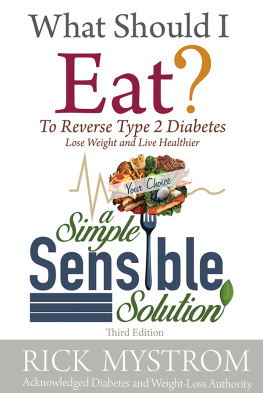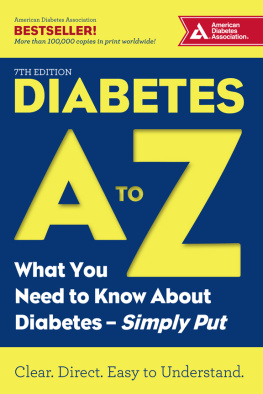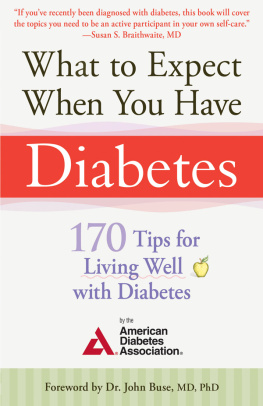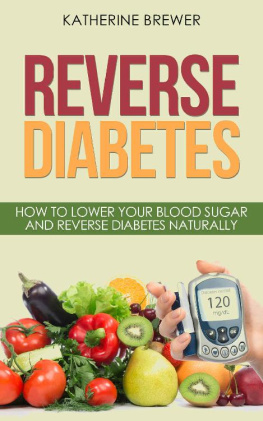JENNY RUHL
Your Diabetes
Questions Answered
Practical Solutions That Work and Keep on Working
TECHNION Books
Copyright 2017 Janet Ruhl
All rights reserved.
P ublished by Technion Books
P.O. Box 402
Turners Falls, MA 01376
technionbooks@outlook.com
Reproduction or translation of any part of this work beyond that permitted by Section 107 or 108 of the 1976 United States Copyright Act without the permission of the copyright owner is unlawful. Requests for permission or further information should be addressed to Permissions Department, Technion Books.
This publication is sold with the understanding that the publisher and author are not engaged in rendering medical or other professional services. If medical advice or other expert assistance is required, the services of a competent professional person should be sought.
All trademarks mentioned in this book remain the property of their respective holders and are used only to reference the products being discussed.
Charts and Checklists
Introduction
T he chances are youve picked up this book because you or someone you care about have been diagnosed with Type 2 Diabetes and youre filled with far more questions than your doctor can answer in the 15 or 20 minutes set aside for your latest appointment. If its been a while since you got that diagnosis, you may have started to wonder why so little of the advice youve received has made any difference. Youve taken the pills your doctor prescribed, but your A1C remains stubbornly diabetic. Youve tried eating the healthy diet described on the Beat Diabetes! flyer you were given and cut out fatty foods, but your fasting blood sugar keeps rising. You may even have joined a gym, but though youve lost a couple pounds, your toes are starting to hurt and your doctor just muttered something about early diabetic neuropathy.
Perhaps youve tried some alternative approaches and filled up your medicine cabinet with strangely named supplements that were supposed to lower your blood sugar but only lowered your bank balance. Maybe youve tried eating an alternative diet where you gave up everything you like to eat in favor of brown rice, raw fruit, and green leaves. When you burnt out on that you may have switched to an Atkins diet and eaten nothing but meat and cheese for a month, which lowered your blood sugar but made your breath stink so badly your spouse threatened to leave if you didnt give it up.
Well, welcome to the club. This kind of journey is what most people go through when they get a diabetes diagnosis. But the frustration they experience during this initial burst of enthusiasm explains why so many people give up fighting their diabetes. They just take the pills theyre given, ignore their weight, and dread their doctors appointments.
This kind of denial can actually work pretty well for a while. Until it doesnt. Feet start to go numb. The doctor mutters about your kidney function tests. The eye doctor tells you they need to see you every three months instead of just once a year.
Ive been there and done quite a bit of all that myself, starting back when I was first diagnosed in 1998. But after going through years of the same kind of trial and error, burnout and denial, I got lucky and ran into some very smart people with diabetes on an online diabetes support newsgroup, alt.support.diabetes. The strategies they described, which made it possible for them to achieve impressive blood sugars, taught me that there are moderate, sustainable ways to control diabetic blood sugars that dont require us to go to extremes. My subsequent research has confirmed that these approaches are safe and will prevent diabetic complications without requiring that we give up everything that tastes good, live at the gym, or obsess about our health 24/7.
Ive been a professional writer since the mid-1980s. So as I started figuring this stuff out, I wrote about it and posted what I wrote online so other people wouldnt have to waste as much time as I had on the error part of trial and error. Those postings eventually morphed into my website, Blood Sugar 101, which I started back in 2005. Since then, Ive kept up with the research about diabetes. Ive added new pages to the site whenever something important emerged and backed up the statements that appeared on the site with documentation that would let readers read the actual studies reported and draw their own conclusions.
The Blood Sugar 101 website grew so large that it became far too big for people to read all of it off of a screen. So in 2008 I turned the information stored on the site into a book, Blood Sugar 101: What They Dont Tell You About Diabetes , which ended up spending two whole years at the very top of the Amazon Diabetes bestseller list. Readers loved it, recommended it to friends, and gave copies as gifts to relatives. These readers have turned Blood Sugar 101 into a diabetes classic. It is still available in a longer, fully revised second edition, published in 2016, which is still going strong.
Why This New Book About Diabetes?
Since Blood Sugar 101 came out, Ive gotten hundreds of emails filled with questions from readers. Some, though by no means, all of those questions already were answered in Blood Sugar 101. But my correspondents seemed to have difficulty finding the answers to their questions in that book because of the way the information in it was presented.
This was understandable. Because Im not a doctor or a trained diabetes educator, when I wrote that book I knew I couldnt expect anyone to take my advice seriously unless I backed up every point I made with references to solid, mainstream medical research. To establish that I wasnt just some off-the-wall crank, I had to go into great detail when describing the findings of the vast body of neglected mainstream medical research that supports the legitimacy of the powerful but unconventional strategy for combating diabetes that I laid out there. But that research got pretty technical at times, more technical than some of my readers were comfortable with.
So that made me think that a new book might be helpfulone that focused entirely on answering the kinds of questions my readers wrote me. This book wouldnt need to cite the research that lay behind the answers I would give, because that documentation can already be found on the Blood Sugar 101 website or in the earlier book. Instead this new book would focus on troubleshooting Type 2 Diabetes. It would answer several hundred of the most pertinent questions readers had sent me over the years, dealing with them in the same way that I would have replied to them if Id received those questions in my in-basket.
This is that book.
Some of the questions youll find here are very basic and may repeat information youve seen elsewhere. I answer those questions so that readers who are new to the subject of Type 2 Diabetes will get the grounding they need to be able to follow the more advanced topics covered further on. But many of the questions youll find here are those people with Type 2 Diabetes only know enough to ask years after a diagnosis, after they have tried various approaches and run into the problems that arise while trying to make them work. Those questions are rarely answered in other diabetes books currently on the market, because so few of those books are written by people who have lived with diabetes. These are questions that only a person with diabetes would think to askor be able to answer.
Though there is some overlap here with what you may have read in Blood Sugar 101 , theres also quite a bit I couldnt fit into the older book. In particular, you will find much that is new in this book about how to make the most out of your relationship with your doctor. Since I wrote the first book back in 2008, that relationship has become even more difficult. Insurers now make it much tougher to get some of the prescriptions many of us need, and doctors rely a lot more on our A1C test results than they used to. These factors are making it much tougher to get the help we need to achieve the normal blood sugars that will keep us from developing the complications too many of our doctors assume are inevitable.
Next page

